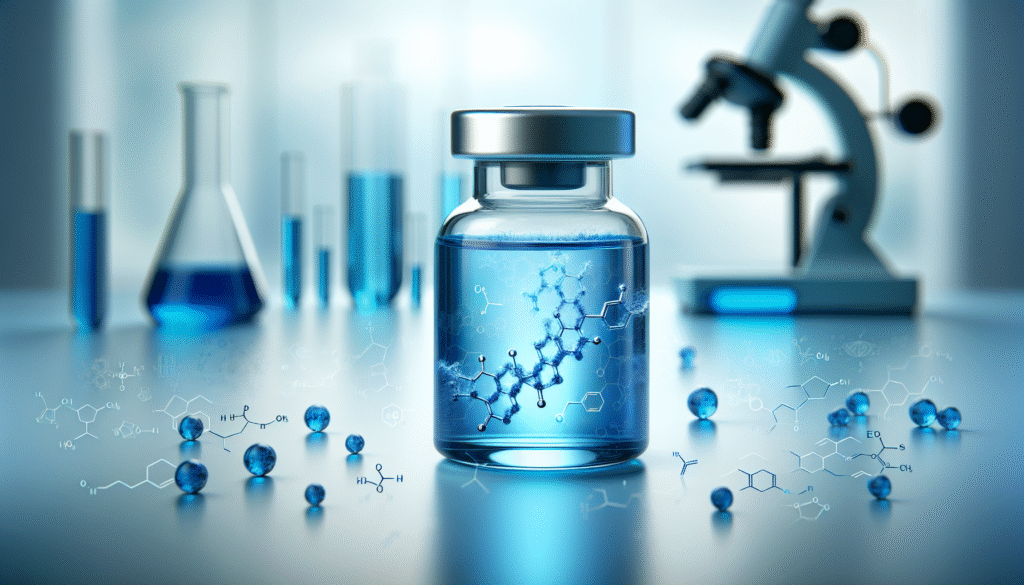
Have you ever wondered how certain medications exert their effects on the human body at a molecular level? One such compound that has gained attention in recent years is Methylene Blue (MB). This remarkable dye, originally used in various industrial applications, has found its way into the medical field and is credited with numerous therapeutic properties.

The Historical Context of Methylene Blue
Understanding Methylene Blue’s rich history provides valuable insights into its contemporary uses. Initially synthesized in the 19th century as a textile dye, MB was later discovered to have antimicrobial properties.
Early Medical Applications
Methylene Blue has been employed in the treatment of various conditions, including malaria. Its ability to inhibit the growth of certain pathogens marked a turning point in its application. MB’s use in clinical settings reflects its adaptability and effectiveness.
Evolution of Therapeutic Uses
Over time, researchers have identified a multitude of potential applications for Methylene Blue beyond its original scope. Today, it is associated with treatments for conditions such as methemoglobinemia and even Alzheimer’s disease, showcasing its versatility as a therapeutic agent.
Chemical Structure and Properties of Methylene Blue
To appreciate Methylene Blue’s mechanism of action, it is crucial to understand its chemical structure and properties.
Structure of Methylene Blue
Methylene Blue is a thiazine dye consisting of a phenothiazine ring and an amino group. This unique structure plays a significant role in its functionality.
| Component | Description |
|---|---|
| Phenothiazine Core | A crucial structural component that imparts its color. |
| Amino Group | Enhances solubility in aqueous environments. |
Solubility and Stability
Methylene Blue is soluble in water, which aids its absorption in biological systems. Its stability under various pH conditions allows it to function effectively within different physiological environments.
Methylene Blue’s Mechanism of Action
Now that you have an understanding of Methylene Blue’s background and properties, let’s explore its mechanism of action in a more detailed manner.
Reduction-Oxidation (Redox) Reactions
At the core of Methylene Blue’s effectiveness lies its ability to participate in redox reactions. This chemical process involves the transfer of electrons, and MB acts as an electron acceptor in biological systems.
Role as an Electron Acceptor
In hypoxic conditions, cells often struggle to generate sufficient energy due to inadequate oxygen supply. Methylene Blue can accept electrons from reduced nicotinamide adenine dinucleotide (NADH), facilitating the production of adenosine triphosphate (ATP) despite the lack of oxygen.
Impact on Cellular Respiration
MB’s role in these redox reactions significantly impacts cellular respiration.
Enhanced Mitochondrial Function
By accepting electrons, Methylene Blue can enhance mitochondrial function. This phenomenon is particularly important in conditions characterized by mitochondrial dysfunction, such as neurodegenerative diseases.
| Condition | Mechanism of Action |
|---|---|
| Mitochondrial Dysfunction | Restores ATP production via electron transport chain. |
| Neurodegenerative Diseases | Mitigates oxidative stress and promotes neuronal health. |
Neuroprotective Effects of Methylene Blue
As scientific research progresses, the neuroprotective properties of Methylene Blue have come to the forefront.
Alleviation of Oxidative Stress
Methylene Blue has been shown to exhibit antioxidant properties, which is vital in protecting neurons from oxidative stress. By scavenging free radicals, MB protects cellular components, thereby maintaining neuronal integrity.
Modulation of Neurotransmitter Systems
In addition to its antioxidant capabilities, Methylene Blue interacts with various neurotransmitter systems, influencing mood and cognitive function.
Serotonin Modulation
Research indicates that MB can modulate serotonin levels, enhancing mood and potentially providing therapeutic benefits for conditions such as depression.
Research on Methylene Blue in Alzheimer’s Disease
A growing body of evidence supports the use of Methylene Blue as a treatment for Alzheimer’s disease, primarily due to its influence on tau protein aggregation and amyloid-beta plaque formation.
| Mechanism of Action | Effect on Alzheimer’s Disease |
|---|---|
| Inhibition of Tau Aggregation | Reduces neurofibrillary tangles associated with AD. |
| Modulation of Amyloid-Beta | Decreases plaque formation and enhances clearance. |
Clinical Applications of Methylene Blue
With a clearer understanding of Methylene Blue’s mechanism of action, it is essential to consider its clinical applications.
Uses in Emergency Medicine
Methylene Blue is primarily known for its role in treating methemoglobinemia, a condition where hemoglobin is unable to effectively release oxygen to tissue.
Treatment Protocol
The standard protocol for treating methemoglobinemia with MB includes IV administration, where dosages usually range between 1-2 mg/kg of body weight.
Potential in Neurological Disorders
Ongoing research is exploring Methylene Blue’s applications in various neurological disorders, including traumatic brain injury (TBI) and mood disorders.
Clinical Trials and Outcomes
Preliminary results from clinical trials indicate that MB may improve outcomes in patients with TBI by enhancing mitochondrial efficiency and reducing oxidative stress.
Methylene Blue in Cancer Therapy
Emerging studies have investigated the potential of Methylene Blue in cancer therapy, particularly in photodynamic therapy (PDT).
Mechanism in Cancer Treatment
MB’s capability to generate reactive oxygen species (ROS) upon laser exposure can selectively target and destroy cancer cells, making it a promising adjunctive treatment in oncology.

Safety and Side Effects of Methylene Blue
While Methylene Blue offers numerous benefits, safety remains a paramount concern.
Common Side Effects
Some side effects associated with Methylene Blue use include:
| Side Effect | Description |
|---|---|
| Discoloration of Urine | MB can cause a noticeable blue discoloration of urine. |
| Gastrointestinal Issues | Nausea and diarrhea may occur in some patients. |
Contraindications
Certain populations should avoid Methylene Blue, particularly individuals with:
- G6PD deficiency
- Serotonin syndrome risk
- Pregnant or breastfeeding women
Conclusion
In summary, your journey into understanding Methylene Blue’s mechanism of action highlights its complex interactions within biological systems. From its historical roots as a dye to its modern-day promise in treating a myriad of health conditions, Methylene Blue stands out as a remarkable compound.
The depth of its mechanism—spanning redox reactions, neuroprotection, and effects on neurotransmitter systems—illustrates why ongoing research continues to explore its therapeutic potential. If you’re considering Methylene Blue for treatment purposes, it is always wise to consult with a healthcare professional to navigate its benefits and risks carefully. As science progresses, the horizons of Methylene Blue may expand further, and its role in medicine is likely to evolve in exciting and transformative ways.